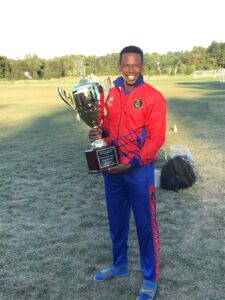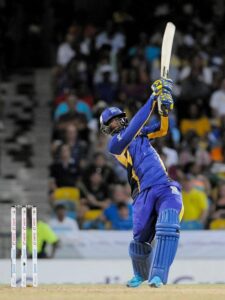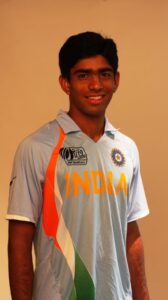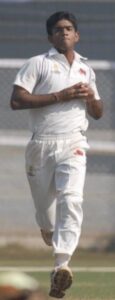While most pro athletes in this country have followed a relatively linear and predictable path in order to make it to the top of their game, there’s no template, blueprint, or well-traveled path for professional cricketers in the US. To make it to Minor League Cricket, players have had to navigate some pretty interesting routes (read parts one, two, three, four and five for more stories). Steve Steinberg from CricAmerica talked with two players who have not only made it to the top of American cricket, they’ve both earned the right to be called Captain.
Navin Stewart – Empire State Titans
An early supporter of cricket in the US, West Indian Navin Stewart has spent more time playing in the States than most international players. His career has also taken him to all corners of the cricketing world and allowed him to play alongside some of the best players of this era.
“As a child I played a lot of sports. I was very much into football — or as you guys call it, soccer. Half of the year I would play soccer and the next half I would play cricket. At the age of 17, I was making good strides in cricket and I made the Tobago Under-19 team. I’m from Tobago, which is the smaller sister island of the twin island republic of Trinidad and Tobago. Eventually, I made the journey across to Trinidad because there were more opportunities there and I got a sporting scholarship to go to university and play sports.”
The move to Trinidad forced Navin to up his game. “I would practice and play against — and with — some of the better players in the country. I was exposed to better coaching. It was a learning curve for me, but I was very keen on making this a profession. And then came my first-class debut and my T20 debut.”
He got his first real taste of international competition playing in the Champions League for several years. Here, the top T20 teams from the different cricketing nations went head-to-head. “That was the best franchise tournament that I’ve played in, to be honest. No disrespect to the others, but It was the crème of the crème. Kieron Pollard came through that system. Sunil Narine came through that system. I remember playing against Steve Smith. He was coming in at number nine and bowling leg spin.”
And then came the Caribbean Premier League. Unlike previous domestic tournaments, teams weren’t defined by national boundaries. Players were drafted by the individual teams. “It was the new franchise culture. I wasn’t playing for Trinidad and Tobago because I had been drafted by the Guyana Amazon Warriors. It was a bit of a strange feeling playing in the Queen’s Park Oval (in Trinidad). A lot of the fans could not grip the concept, because Guyana versus Trinidad is one of the biggest rivalries. When we beat Trinidad, we were referred to as traitors. But those were very good moments for me. The CPL really gave me an opportunity to enhance my reputation as a player. And from those performances, I was given a lot of opportunities to play in the USA.”
While a lot of international players looked down at what was happening in the US cricket-wise some ten or twelve years ago, Navin embraced it. “In 2010, I got the opportunity to come to the US to be a part of the US Open in Florida. And ever since, I’ve been coming back. I’ve been saying for a long time that given the infrastructure of cricket in the US and the amount of matches that you play throughout the season, it was only a matter of time before cricket in the US would rise.”
“Guys used to laugh at me, but now when I turn up for tournaments here, I’m playing against some of those very same guys who would have laughed at me because they didn’t see the same vision. In anything, you can’t count out America. It just took an organization like Minor League Cricket/Major League Cricket to put something together and now they’re attracting attention from players all over the world. Unmukt Chand is there. Smit Patel is there. Harpreet Singh is there. Narsingh Deonarine from the Caribbean is there.”
And Navin Stewart is there. “In 2020, they had the exhibition minor league and I was playing for the DC Hawks. A couple of guys went down with Covid, so we only played a couple of matches. But in those two games I had nine wickets. And in a game against the Empire State Titans in Philly, when I walked in to bat we needed like 78 from six overs and I scored 69 not out from 21 deliveries with nine sixes. So, this past minor league season, Empire State reached out to me. I was grateful for the opportunity and at the start of the season I was named captain.”

But it was a mid-season trip to the league’s marquee ground in Morrisville, North Carolina that he found particularly eye-opening. “It was amazing. It’s the most beautiful, picturesque venue in the States. We had two games there and we were so impressed. You had to pinch yourself to make sure you were still in America. It was packed to capacity. Drums were playing. It seemed like you were back home in your country.”
And the team rallied around that experience in Morrisville. “When we got back to New York, getting back to Morrisville for the playoffs was our goal because of the fun experience we had there. With the pandemic, a lot of games are played behind closed doors. It was refreshing as players to be given the opportunity to play in front of a packed crowd. It was surreal to see the standard in terms of broadcasting when we got back for the playoffs. International commentators came in. There were 14 or 15 cameras. For a player who’s played at the next level, I felt like I was back at that next level. And for the younger players, we said ‘Hey, this is your big stage. This is your moment. This is what it feels like to play at the next level.'”
Who would Navin like to play with on his Dream XI? “I don’t want to be too biased, but their records speak for themselves. Sunil Narine and Kieron Pollard, who’s a friend of mine and I’m a big fan of his style of play. And then KL Rahul and Rohit Sharma. Two top order batsmen, one world-class spinner, and one world-class hitter. With that as the nucleus, I’ll build my team around those four players.”
Saurabh Netravalkar – Silicon Valley Strikers
While Marvel Comics’ Captain America may like to take care of his foes with his fists and his shield, cricket’s Captain America prefers to silence the opposition with ball and bat. “Where I grew up is the capital of cricket in India — Mumbai. Most of the people there are cricket-crazy and there’s loads of street cricket and backyard cricket. My dad used to love playing, so I grew up watching him play. And that’s how I got into the game.”

“At the age of 10, I went to open trials at an academy for Under-13s and I got picked, so that’s when I started my formal training. I used to go five days a week for three hours a day. And I started moving up the ranks. And, ultimately, I made my way up to the under-19 team. And I got to play for the national team in the World Cup.”
The 2010 U19 World Cup team that Saurabh played on was sandwiched between championship teams in 2008 (led by Virat Kohli) and 2012 (led by his future Minor League Cricket teammate Unmukt Chand). The 2010 team struggled against both Pakistan and South Africa and finished 6th overall. Interestingly, 2010 was the last time the USA qualified to play in the U19 World Cup. And on that team was current senior team member Steven Taylor.
After graduating college in 2013, Saurabh spent two years playing first-class cricket for Mumbai before deciding to put his cricket on hold and move to the US to pursue his master’s degree in computer science at Cornell University. “It was a quite a big transition. I had never lived away from family. Obviously, I had gone on tours, but there you’re with teammates and you’re playing cricket. But living away was out of my comfort zone. I didn’t know how to cook. I basically started my life from scratch.”
But it wasn’t long before cricket came calling. “When I was at Cornell, I saw a few guys playing cricket. They were mostly senior PhD and master’s guys. They said they had a club team and they asked me to join them. They participated in the American College Cricket tournaments, so we used to travel to Rochester, Boston, and New York City.”
“After I graduated, I got a job in the bay area. I had learned about some club cricket in the bay area, so I started playing for fun to see where it goes. I played for the Marin Cricket Club in the Northern California Cricket Association. Luckily, that team had four US national players at that time. They saw me and said I should start training again, because I had put on weight, I wasn’t training, and I wasn’t fit. That’s what motivated me to start working hard again at cricket. It was as if life had given me a second chance to pursue my passion.”
At the time, the ICC’s rules required someone to have had seven years of residency in a country before being able to qualify for the national team, so playing for the USA wasn’t even on Saurabh’s radar. But there were a lot of club teams and a lot of tournaments. “So, I started traveling. I started playing in LA, Florida, Michigan, Houston, or wherever I had a chance to play. Every Friday I would fly or drive somewhere to play and every Monday I would take a red-eye home and get to work. That’s basically how my first two or three years were.”

And then he got a career-changing break. “I was lucky. The minute I completed two-and-a-half years in the US, the ICC changed the rule and made it three years.” He had already caught the eye of USA coach Pubudu Dassanayake and when Ali Khan got injured, there was a spot for a fast bowler. Saurabh got his chance and he never looked back. Three tournaments later, he was named captain of the USA team.
His luck continued when he ended up with the Silicon Valley Strikers of Minor League Cricket. “The first exhibition season we had I was playing for the (Golden State) Grizzlies. The three bay area teams are very close. It’s a good community. We all practice together. We all train together. So, I was going to end up being part of one of the bay area teams. And it worked out for the best. I had good people to work with. Unmukt was great. We created a good culture.”
And how did he find the response to the inaugural season of the league? “To start with, it was just friends and family of the guys that were playing. But by the time we got to the finals, it was a dream come true. Such a great crowd. Such great hospitality. There was cheering. There were banners. It was really nice to see. And Major League Cricket can take it to the next level. The US is one of the biggest markets, so it could be on par with some of the best leagues in the world if executed well.”
And in the recent series against Ireland, Saurabh experienced first-hand how the national team is reaping the benefits of Minor League Cricket. “A fair chunk of our core players were not available, so it was good to see the youngsters and the U19 players on the team. There were a few new faces that had done well during the minor league season, so it validated our domestic cricket program. I think that’s a good rule that minor league has where you have to play an under-19 and an under-21. It ensures that you’re growing the game at the grass roots level.”
Who would Saurabh want to play with on his Dream XI? “I’m kind of an old-school cricketer, so I like the basics. My all-time idol is Glenn McGrath for his accuracy and the skills that he brings to the game. Wasim Akram for his swing. Rahul Dravid for the way he goes about carrying himself. He’s a great ambassador for the game. And Zaheer Khan, who was one of the top bowlers for India and someone that I’ve looked up to.”




